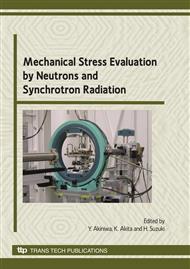p.1
p.7
p.13
p.19
p.25
p.31
p.37
p.44
p.50
Determination of the Residual Stress Field around Scratches Using Synchrotron X-Rays and Nanoindentation
Abstract:
The residual strain field around the scratches of 125µm depth and 5µm root radius have been measured from the Synchrotron X-ray diffraction. Scratches were produced using different tools in fine-grained aluminium alloy AA 5091. Residual stresses up to +1700 micro-strains were measured at the scratch tip for one tool but remained up to only +1000 micro-strains for the other tool scratch. The load-displacement curves obtained from nanoindentation were used to determine the residual stresses around the scratches. It was found that the load-displacement curves are sensitive to any local residual stress field present and behave according to the type of residual stresses. This combination of nanoindentation and synchrotron X-rays has been proved highly effective for the study of small-scale residual stresses around the features such as scratches.
Info:
Periodical:
Pages:
25-30
Citation:
Online since:
May 2010
Authors:
Keywords:
Price:
Сopyright:
© 2010 Trans Tech Publications Ltd. All Rights Reserved
Share:
Citation:


